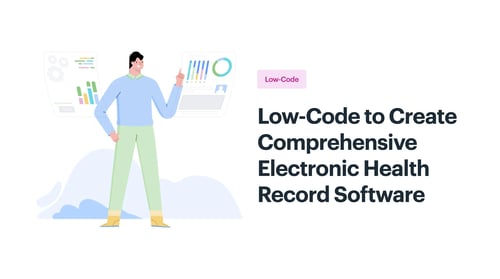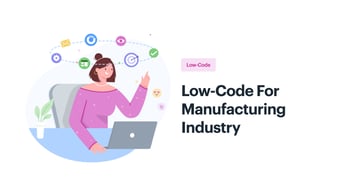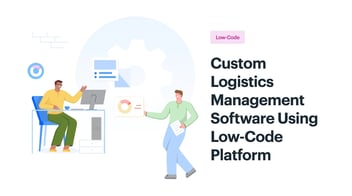
- >
- Low-Code Platform >
- How to Use Low-Code to Create Comprehensive Electronic Health Record Software
How to Use Low-Code to Create Comprehensive Electronic Health Record Software
Team Kissflow
Updated on 28 May 2025 • 8 min read
An Electronic Health Record (EHR) is a software program used to acquire, maintain, and distribute organized medical data. An EHR allows all legitimate users engaged in a patient’s care to communicate medical information, including physicians, labs, pharmaceuticals, emergency rooms, nursing homes, state databases, and patients directly. EHR software nowadays goes beyond simple record management. EHR is evolving into a full clinic management system with useful practice and income managerial skills.
Key Characteristics of an EHR Solution
Convenient Access
Users must be able to utilize the EHR system at any time from any location. As a result, ensuring that your EHR is compatible with a wide range of platforms, operating systems, and smartphones is a must. The majority of efficient software, such as EHR, is a web-based program. This implies that while designing EHR, make sure it works with a variety of browsers, including Chrome, Safari, and Internet Explorer. Furthermore, the customer experience cannot be restricted to a single device. Ensure that the EHR adjusts to the phone’s screen size, whether it’s a PC, tablet, or smartphone.
Ready-to-use Templates
Doctors must make notes for every patient in addition to treating them. They may have to help patients with the same diseases several times and keep track of the same information. Doctors and clinicians should be able to develop templates that can be utilized when visiting patients with similar problems using a decent EHR system. This can save doctors a lot of time by eliminating repetitive tasks and allowing them to visit more patients.
Billing Integration
For both patients and clinicians, a good EMR allows a simple and quick billing system. It eliminates the need for alternative billing software, reducing laborious and time-consuming data input, reducing typing errors, and providing a single centralized system. Accountability can be preserved for both patients and healthcare professionals, since both may view billing history and verify the number of patients, claims paid, and outstanding bills all in one location.
Security and Privacy
Fundamentally, security is the most important element to consider while designing an EHR app. The app holds and communicates the patient’s personal health information, also known as PHI (protected health information), which must be kept private at all times. And, to do so, EHR software must follow the criteria outlined in the Health Insurance Portability and Accountability Act (HIPAA).
Experience the power of low-code with the simplicity of no-code.
Guidelines to make your EHR system HIPAA compliant
1. Develop the organization’s privacy and security policies
Following the HIPAA Security and Privacy Rules isn’t enough to become HIPAA compliant. Covered businesses and company associates must also demonstrate that they have created privacy and security policies to prevent HIPAA breaches. These policies must be recorded, communicated to employees, and updated regularly. During orientation and at least once a year, staff must be briefed on HIPAA policies, and they must affirm (in paper) that they follow all HIPAA guidelines and standards.
Patients must also study and sign a Notice of Privacy Practices (NPP) form that healthcare organizations must generate and distribute. The NPP should include a description of the covered entity’s privacy practices, including how PHI is handled, as well as information on patients’ rights to get copies of their medical records.
2. Designate a HIPAA privacy and security officer
Because HIPAA regulations are complex and constantly changing, every healthcare company should have its own internal HIPAA professionals.
The HIPAA Security Rule requires covered businesses to appoint a Privacy Compliance Officer to manage the creation of privacy policies, as well as ensuring that they are maintained and updated regularly. Larger companies should create a Privacy Supervision Committee, according to HHS, to help direct policy formulation and monitor oversight. To keep up to date on HIPAA regulations, the Privacy Officer and members of the Oversight Committee must attend training regularly. The HIPAA Privacy Officer is also in charge of keeping NPPs, monitoring and upgrading BAAs, arranging practice sessions and self-audits, and assuring that the business complies with the HIPAA Privacy Rule in other ways.
A HIPAA Security Officer is also needed for covered businesses to ensure that policies and processes for preventing, detecting, and responding to ePHI privacy violations are in place. The Security Officer implements the Security Rule’s protections and performs risk assessments to determine their efficacy.
3. Set up security measures
Covered businesses and business associates must have three types of protection in place to protect electronic protected health information (ePHI), according to the Security Rule:
-
Administrative security:
Security management processes must be documented, security employees should be designated, and information access management systems should be implemented, workforce security training should be provided, and all security measures must be evaluated regularly. -
Physical security:
Accessibility to physical facilities where ePHI is kept should be controlled by organizations. They must also protect any terminals and devices that hold or send electronic protected health information (ePHI).
-
Technical security:
To guarantee that workers only see data they are allowed to see, organizations must implement access controls to safeguard ePHI in EHRs and other databases. Secure email, HIPAA Compliant Texting, and HIPAA Compliant Messaging solutions are required to encrypt data while it is in transit and at rest. To guarantee compliance with HIPAA network standards, organizations must have audit controls in place for any hardware and software that manages or transmits ePHI. Integrity controls must also be in place to guarantee that ePHI is not inappropriately altered or destroyed.
-
Perform risk assessments and self-audits regularly:
It’s not a one-and-done procedure to become HIPAA compliant. To detect compliance deficiencies, HHS (Health and Human Services) requires covered businesses and business associates to perform frequent (at least yearly) audits of all administrative, technological, and physical protections. The next step is for organizations to establish written remediation plans that detail how they aim to correct HIPAA breaches and when they plan to do so.
-
Keep your business associate agreements updated:
Before exchanging PHI with business partners, covered organizations must acquire sufficient assurances that the business associate is HIPAA-compliant and capable of properly safeguarding the data, as well as a BAA (Business Associate Agreement) between the two parties. Every BAA must be evaluated and modified on an annual basis to represent any shift in the composition of the business associate relationship.
-
Create a protocol to notify folks about security breaches:
A HIPAA violation may not necessarily result in a fine, especially if the breach was accidental and the business did all possible to avoid it. However, neglecting to report security breaches exacerbates the problem. The HIPAA Breach Notification Rule requires covered organizations and business associates to inform patients whose personal data may have been exposed and to disclose any breaches to OCR. Organizations subject to HIPAA must have a written breach notification procedure that describes how they will adhere to the rule.
-
Keep a record of everything:
All HIPAA compliance activities, such as privacy and security policies, risk assessments and self-audits, remedial plans, and staff training sessions, must be documented. During HIPAA audits and complaint investigations, OCR will evaluate all of this material.
Compliance with HIPAA is important for healthcare businesses, not just to preserve patient privacy but also to safeguard their financial line. Healthcare providers must understand how to become HIPAA compliant to keep data safe, and they must work with technology partners that take data security as seriously as they do.
Don’t know how to code? You can still build apps without depending on IT.
How Do You Build an EHR System?
Nowadays, many shops, particularly those in small and medium-sized businesses, have few developers who create new apps from the ground up. They do have coders that set up, code, and interface numerous apps, but they don’t build anything. We have a tendency of either sourcing the needs from our Electronic Health Records (EHR) software vendor or purchasing a “best of breed” application from a specialty vendor in the provider community. Even the fear of upgrading has decreased after switching to Software as a Service (SaaS). Today’s difficulties necessitate a new “low-code” strategy. Low-code refers to an application development environment that is mostly visual and creates programs using simple declarative assertions. The fundamental purpose of low-code is to speed up the delivery of programs. Every healthcare IT team should strive towards this. As business clients embrace low-code, they may ensure preparedness by putting these building blocks in place, allowing them to reap the benefits promised:
Preparation
It’s critical to examine the adoption of authentication best practices before implementing a low-code application platform (LCAP). The technological environment today includes on-premises, private cloud, and public cloud solutions, necessitating a consistent, tokenized authentication strategy. Without it, security procedures would either fall short of the CISO’s objectives or will require more staff to monitor and manage.
Security measures
OAuth is the building block for scalable secure authentication because of the number of suppliers, settings, and the velocity of human contacts (non-employee physicians, transient personnel of all sorts, patients, etc.). OAuth is a distributed authentication method that eliminates the requirement for program calls to submit passwords (APIs). The accessibility norm, which serves as a framework for data exchange, has been mandated by CMS. Invest in a centralized identity management system and migrate to using OAuth to verify service and access requests if you haven’t already. The importance of standardizing authentication cannot be overstated. Do that before deciding on a low-code provider.
LCAP systems provide several different ways to get data from other apps. Files, database calls (Open database, JDBC, etc.), and scripting are all common integration mechanisms. The moment has come to embrace API-First and design thinking. Stop developing point-to-point integrations; if APIs aren’t standardized, LCAP will result in a profusion of connection techniques.
Administration
The administration and management of your new agile apps, particularly their interfaces with your core corporate systems and external connections, is last but not least. We’ve all seen it happen: a new software or upgrade is installed, and productivity plummets. To effectively prevent code errors and protect your customer from malicious actors, checking and monitoring access (restricted access to data) is critical. To accomplish the goals of distribution speed and resource efficiency, it is important to know who is accessing what and how the load fluctuates.
Stop coding. Start building. Drag, drop, and repeat.
Advantages of Electronic Health Record (EHR)
EHRs have several advantages, including the ability to improve patient care and automate several activities for the practice. They also allow doctors to share the information with others virtually and in real-time, ensuring that any clinician working with a patient has access to the most up-to-date, full, and precise file possible. Additionally, they are extremely adaptable and may be set up to meet the needs of your medical practice.
1. Improved Care Quality:
By allowing rapid access to patient records, EHR helps healthcare providers offer better patient care, leading to more effective treatment. They also increase the physician’s operational efficiency while improving therapeutic efficacy. Most EHRs give physicians the health analytics that helps them detect trends, forecast diagnoses, and propose possible treatment choices. Rather than depending on trial-and-error approaches, these low code statistics lead to more effective overall patient outcomes the first time. Patients have access to patient data, which provides them with previous medical data such as lab and radiology results, medicines, diagnoses, and other data. Patients can connect with their doctors via sharing notes, sending instant messaging, or even video conferencing. Likewise, travel radiology techs who typically work at different facilities and may not be familiar with a patient's medical history can access it remotely through the EHR. The portal may be used by both clinicians and patients to follow a patient’s treatment progress. This also simplifies preventative care.
2. Accurate patient Data:
Electronic files, which were first offered as a replacement to paper medical records to make keeping and retrieving patient information simpler, now provide some additional benefits. For starters, keeping information online removes the danger of confidential data being stolen, misplaced, damaged, or altered. Digital records can also prevent faults and inaccuracies caused by handwriting and legibility difficulties. Physicians may change patient information in real-time, providing an up-to-date, accurate patient file to other healthcare providers. This computerized record can link any clinician or expert involved in a patient’s treatment at any time. Consistency is beneficial, particularly when a patient moves physicians or visits a new physician because it gives providers a thorough backdrop of the patient’s condition instead of forcing them to start from the beginning.
3. Increased Effectiveness:
EHR, as previously said, allows physicians to deliver more precise diagnosis and treatment while also saving time. They reduce wait times for consultations and office visits while maintaining a patient-centered strategy, allowing health practitioners to see more patients daily. EHRs include a template to assist clinicians in documenting typical patient complaints or concerns. These templates are frequently customized to meet a physician’s unique needs or adapted to specific specializations. Artificial intelligence (AI) is making headway into electronic health record (EHR) systems. It aids clinicians in diagnosing patients and understanding their medical information. A few firms have also included voice control capabilities, allowing providers to ask questions to the apps through speech.
Wrapping up
To summarize, EHR is the healthcare industry’s move to the digital world to better manage and treat patients’ data. It has accomplished for the health sector what online banking and e-commerce did for banks and shopping — by automating the system for faster and more efficient service. Building a bespoke EHR, on the other hand, is more difficult and time-consuming than developing any other program. After all, a solution that records patient data to assist doctors in providing better care requires a high degree of complexity, including increased security, features, and expertise. As doctors become more mobile and require apps, low-code application development platforms are increasing appeal in the healthcare business. Companies have the option of developing unique healthcare applications that are tailored to each department.
See why enterprises trust the Kissflow platform for agility and control.
.png?width=677&height=2200&name=Low-Code_Infographic_2_(1).png)
Kissflow Low-Code Development Platform
Get in touch with us to learn more about how you can transform your application needs.
Related Articles











